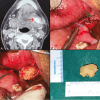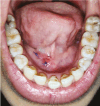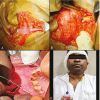A Comprehensive Study of Combined Approach Sialendoscopy in Managing Salivary Gland Sialolithiasis
- PMID: 40552906
- PMCID: PMC12232978
- DOI: 10.4274/tao.2025.2024-8-13
A Comprehensive Study of Combined Approach Sialendoscopy in Managing Salivary Gland Sialolithiasis
Abstract
Objective: Obstructive salivary gland diseases were traditionally managed conservatively, with surgical treatment reserved for refractory cases only. These surgeries, ranging from papillotomy to sialadenectomy, often involved numerous complications. In the past two decades, sialendoscopy, a minimally invasive technique, has made tremendous progress due to its advantages. This study aims to describe the efficacy of combined approach sialendoscopy as a minimally invasive option for large-sized sialolithiasis that is not amenable to sialendoscopy alone.
Methods: It is an ambispective study of 12 patients over a span of 3.5 years at a tertiary care center conducted with all consenting patients who were treated with combined approach sialendoscopy. Ultrasonography and computed tomography of the patients was done. Therapeutic intervention in the form of combined approach sialendoscopy was done at the same sitting as diagnostic sialendoscopy and postoperative follow-up was conducted for a duration of six months.
Results: In this study of 12 patients undergoing sialendoscopy, glandular swelling was a universal presenting symptom, with 80% patients exhibiting meal-stimulated exacerbation and post-massage relief. Submandibular involvement predominated (83%), with parotid cases comprising the remainder. All patients had sialoliths >6 mm and underwent combined approach sialendoscopy, yielding a 100% immediate symptomatic resolution rate. Recurrence occurred in 16%, successfully managed with repeat sialendoscopy.
Conclusion: As endoscopy is integral to otorhinolaryngology, sialendoscopy represents the evolution of minimally invasive salivary gland surgery. This study highlights the different methods of combined approach sialendoscopy in managing larger as well as distally placed sialoliths, thus reinforcing its role as a superior gland-preserving modality.
Keywords: Sialolithiasis; combined modality therapy; minimally invasive surgical procedures; salivary glands; sialendoscopy.
©Copyright 2025 by Turkish Otorhinolaryngology-Head and Neck Surgery Society / Turkish Archives of Otorhinolaryngology is published by Galenos Publishing House.
Conflict of interest statement
Conflict of Interest: There is no conflict of interest to disclose.
Figures




Similar articles
-
Standardization of Basket Use in Sialendoscopy: A Ten-Year Retrospective Study.J Vis Exp. 2025 Jun 6;(220). doi: 10.3791/68055. J Vis Exp. 2025. PMID: 40549674
-
Management of obstructive salivary disorders by sialendoscopy: a systematic review.Br J Oral Maxillofac Surg. 2015 Jul;53(6):507-19. doi: 10.1016/j.bjoms.2015.02.024. Epub 2015 Mar 29. Br J Oral Maxillofac Surg. 2015. PMID: 25823614
-
Does Augmenting Irradiated Autografts With Free Vascularized Fibula Graft in Patients With Bone Loss From a Malignant Tumor Achieve Union, Function, and Complication Rate Comparably to Patients Without Bone Loss and Augmentation When Reconstructing Intercalary Resections in the Lower Extremity?Clin Orthop Relat Res. 2025 Jun 26. doi: 10.1097/CORR.0000000000003599. Online ahead of print. Clin Orthop Relat Res. 2025. PMID: 40569278
-
Effectiveness of sialendoscopy for salivary gland occlusions.Dan Med J. 2025 May 21;72(6):A11240783. doi: 10.61409/A11240783. Dan Med J. 2025. PMID: 40557862
-
The Black Book of Psychotropic Dosing and Monitoring.Psychopharmacol Bull. 2024 Jul 8;54(3):8-59. Psychopharmacol Bull. 2024. PMID: 38993656 Free PMC article. Review.
References
-
- Bachalli PS, Moorthy A. Obstructive salivary gland disease and sialendoscopy. Bonanthaya K, Panneerselvam E, Manuel S, Kumar VV, Rai A, editors. Oral and Maxillofacial Surgery for the Clinician. Singapore: Springer; 2021. p. 975-80.
-
- Hald J, Andreassen UK. Submandibular gland excision: short- and long-term complications. ORL J Otorhinolaryngol Relat Spec. 1994;56:87–91. - PubMed
-
- Scully C. Lumps and swellings in the salivary glands. Oral and Maxillofacial Medicine. 3rd ed. London: Churchill Livingstone; 2013.
LinkOut - more resources
Full Text Sources
Research Materials
Miscellaneous
